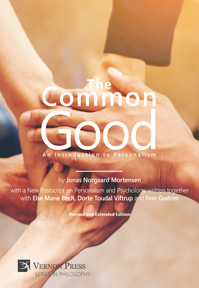Dimensions of Shared Agency: A Study on Joint, Collective and Group Intentional Action
by Giulia Lasagni (Europa-Universität Flensburg, Germany)
Purchase this book
(click here to change currency)
Giulia Lasagni presents systematic and thorough readings of accounts of shared agency in analytical social ontology. She does a wonderful job in managing to present the rich debate in a manageable format, making original suggestions and metalevel observations about the points of the debates.
Prof. Arto Laitinen
Tampere University, Finland
"Dimensions of Shared Agency" investigates the way in which standard philosophical accounts have been dealing with the issue of collective actions. In particular, the book focuses on the ‘Big Five’ of analytical social ontology (namely, Michael Bratman, Margaret Gilbert, Philip Pettit, John R. Searle and Raimo Tuomela) and their accounts of shared/collective intentions and actions. Through systematic readings of different positions in the debate, the author proposes original ways of analyzing and classifying current theories of shared agency according to whether they advance a member-level or a group-level account of shared agency. While member-level accounts (MLA) are theories of shared agency based on individuals’ attitudes and actions, group-level accounts (GLA) give attention to the group of individuals considered as a whole, i.e., as an agent itself.
Criticism arises against the idea that the Big Five have proposed stable group-level accounts suitable for explaining the case of shared agency as a group-level phenomenon. The widespread tendency in the debate is to endorse a perspective called holistic individualism, which maintains that high-level explanations are objective even though social facts are ontologically reducible to facts about individuals. Lasagni argues that as long as holistic individualism is held, the GLA is reducible to the MLA because holistic individualism upholds ontological individualism based on a deep individualistic premise, fixing the special status of individual agents as natural persons. The premise makes the claim to treat groups as agents contradictory to the general framework of the theory. This book profiles an alternative interpretation according to which agency should be considered as a functional kind, which is equally instantiated by different systems, such as individual human beings and organized social groups. In this way, the author claims, the reduction of the social can be avoided.
"Dimensions of Shared Agency" will be of interest to doctoral students, researchers, and scholars interested in social ontology and the philosophy of the social sciences. It can also be utilised as supplementary reading or an introduction to philosophy students and scholars who are first approaching the philosophy of collective intentionality and shared agency.
List of tables and figures
Acknowledgments
Introduction
1. The topic
2. The debate
3. The theory
4. The approach
5. The desideratum
6. The structure
Part One. Shared agency
Chapter 1 The continuity-thesis account
1.1 Survey of Part One
1.2 Agency according to Bratman
1.3 The building blocks of shared agency
1.4 Bratman and the participatory-intention account
Chapter 2 The discontinuity-thesis account
2.1 The discontinuity thesis of intentionality
2.2 Searle’s collective intentionality
2.3 We-mode we-attitudes: Tuomela’s proposal
2.4 Gilbert on joint actions
Chapter 3 Shared agency and the member-level account (MLA)
3.1 A distributive interpretation
3.2 Four dimensions of shared agency
3.3 A few points on the four dimensions
3.4 Agency relations in member-level accounts
3.4.1 Constitutive relation
3.4.2 Structural relation
3.4.3 Normative relation
3.4.4 Causal relation
Part Two. From member-level to group-level accounts
Chapter 4 The subject of shared agency
4.1 Survey of Part Two
4.2 The intrinsic account
4.3 The extrinsic account
4.4 The status account
Chapter 5 Holistic individualism
5.1 The (apparent?) paradox
5.2 Traditional positions
5.3 Three issues in social ontology
5.4 Holistic individualism and shared agency
Chapter 6 The supervenience of group-level facts
6.1 Supervenience relation
6.2 Ontology and methodology
6.3 The group-level account (GLA)
6.4 The GLA and the four agency relations
6.4.1 Constitutive relation
6.4.2 Structural relation
6.4.3 Normative relation
6.4.4 Causal relation
Part Three. Shared agency as group agency
Chapter 7 Holistic individualism and flaws in the GLA
7.1 Restarting from Part Two
7.2 Problems of constitutive and structural relation
7.2.1 Constitutive relation
7.2.2 Structural relation
7.3 The normative issue
7.4 Troubles with causality
Chapter 8 A disturbing premise
8.1 A shared trait among shared action theories
8.2 Normativity as constitutive dimension
8.3 Normative and metaphysical individualism(s)
8.4 Second-order assumptions
Chapter 9 Hypothesis for a revision
9.1 Alternative solutions
9.2 On different premises
9.3 The subject of group agency
9.4 How does the GLA relate to the MLA?
Chapter 10 Agency relations in the GLA
10.1 Constitutive relation
10.2 Structural relation
10.3 Normative relation
10.4 Causal relation
Conclusion
List of references
Index
Giulia Lasagni is a post-doctoral researcher at the Europa-Universität Flensburg. She works mainly in social ontology and the philosophy of the social sciences. Her research interests include collective intentionality, group agency, and the metaphysics of social groups. Giulia Lasagni obtained her PhD in philosophy at the University of Parma. During her doctorate, she was a visiting student at the Columbia University in New York and at The Research Institute of the University of Bucharest. As a post-doc, her project “Systems of agency” was funded with a DAAD research grant and developed at the Europa-Universität Flensburg. She was then associated to the research project “Value Pluralism and Conflict” at the University of Parma.
Social ontology, collective intentionality, action theory, social groups, group agency, social structure, individualism, holism
See also
Bibliographic Information
Book Title
Dimensions of Shared Agency: A Study on Joint, Collective and Group Intentional Action
ISBN
978-1-64889-127-4
Edition
1st
Number of pages
233
Physical size
236mm x 160mm

![Dimensions of Shared Agency: A Study on Joint, Collective and Group Intentional Action [Hardback]](/file/15139/037800b152d870c30acf9a989081daf4/1626342114.jpg)







